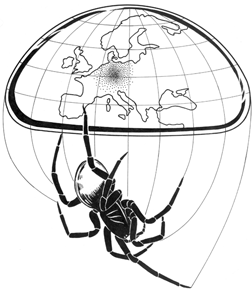Arachnologische Mitteilungen
https://arages.de/zeitschrift/arachnologische-mitteilungenDunlop JA, Krüger J & Alberti G
The sejugal furrow in camel spiders and acariform mites
The sejugal furrow in camel spiders and acariform mites
Heft 43
Camel spiders (Arachnida: Solifugae) are one of the arachnid groups characterised by a prosomal dorsal shield composed of three distinct elements: the pro-, meso- and metapeltidium. These are associated respectively with prosomal appendages one to four, five, and six. What is less well known, although noted in the historical literature, is that the coxae of the 4th and 5th prosomal segments (i.e. walking legs 2 and 3) of camel spiders are also separated ventrally by a distinct membranous region, which is absent between the coxae of the other legs. We suggest that this essentially ventral division of the prosoma specifically between coxae 2 and 3 is homologous with the so-called sejugal furrow (the sejugal interval sensu van der Hammen). This division constitutes a fundamental part of the body plan in acariform mites (Arachnida: Acariformes). If homologous, this sejugal furrow could represent a further potential synapomorphy for (Solifugae + Acariformes); a relationship with increasing morphological and molecular support. Alternatively, outgroup comparison with sea spiders (Pycnogonida) and certain early Palaeozoic fossils could imply that the sejugal furrow defines an older tagma, derived from a more basal grade of organisation. In this scenario the (still) divided prosoma of acariform mites and camel spiders would be plesiomorphic. This interpretation challenges the textbook arachnid character of a peltidium (or ‘carapace’) covering an undivided prosoma.
Acariformes; morphology; outgroups; phylogeny; Solifugae; tagmosis


